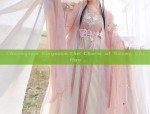The Song Dynasty Hanfu:The Commoners Attire in Song Dynasty
In The Song Dynasty (960-1279 AD), Hanfu, the traditional Chinese clothing, experienced a remarkable evolution that reflected the cultural and societal changes of the era. While the nobility and elite wore elaborate and intricate costumes, the commoners also had their own distinct style of Hanfu attire that was tailored to their everyday lives and social status.

The Song Dynasty saw a shift in fashion where the Hanfu became more practical and less ceremonial in nature. This was due to the economic and social progress of the era, which allowed for more freedom in clothing choices. The commoners, who were the backbone of society, wore Hanfu that was simple yet elegant, reflecting their everyday lives and societal norms.
Materials used in making Hanfu during the Song Dynasty were primarily cotton and silk, which were affordable to the commoners. The colors of the Hanfu were often subdued, with a preference for natural hues like white, gray, brown, and blue, which were easy to dye and maintain.
The commoners' Hanfu was typically made up of a few basic pieces that were easy to wear and combine. The outer layer, known as the 'chang', was often a long robe that was worn over a shorter robe called the 'zhongshan'. These robes were tied at the waist with a belt, which served as a means of adjusting the fit and also as a decorative accessory. The lower part of the robe was often left open, allowing for ease of movement and ventilation.
The commoners also wore hats and caps as part of their attire. These were made from simple materials like straw or cloth and were often decorated with simple patterns or embroidery. These hats and caps not only served to protect them from the sun but also added to their overall appearance and style.
Footwear during this period was also simple and practical. The commoners often wore cloth shoes that were tied with strings or sandals made from bamboo or wood. These shoes were sturdy and provided good grip, essential for walking on various terrains.
The commoners' Hanfu also reflected their occupation and social status. For instance, farmers and laborers often wore more robust and practical clothing that could withstand the rigors of their work, while merchants and craftsmen wore attire that was more refined and stylish, reflecting their profession and status.
The Song Dynasty Hanfu worn by the commoners was not only about fashion but also about comfort and practicality. It was a reflection of their everyday lives, culture, and societal norms. The simplicity of the Hanfu allowed for ease of movement and flexibility, making it ideal for everyday wear. The use of affordable materials like cotton and silk ensured that it was accessible to all sections of society, regardless of their economic status.
In conclusion, the Song Dynasty Hanfu worn by the commoners was a blend of tradition and modernity, reflecting the societal changes of the era. It was a symbol of their identity, culture, and everyday lives. The simplicity and elegance of the Hanfu made it not only practical for everyday wear but also a testament to the rich cultural heritage of China.
The study of Hanfu not only reveals the historical significance of traditional Chinese clothing but also sheds light on the societal changes that occurred during the Song Dynasty. It provides a glimpse into the lives of the commoners and their relationship with their culture, traditions, and society.

 Previous Post
Previous Post





